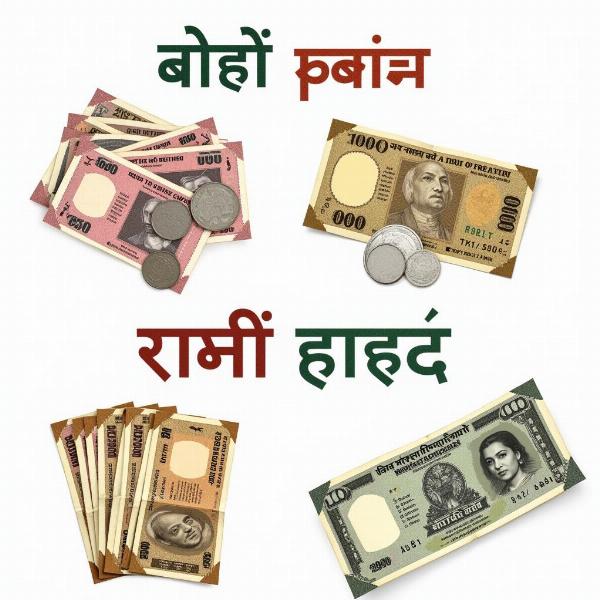Understanding the Hindi meaning of money goes beyond simple translation. It delves into the cultural nuances, social implications, and practical applications of this essential concept in Indian society. While the direct translation of “money” is often “paisa” (पैसा) or “dhan” (धन), the true meaning extends far beyond these words, encompassing values, aspirations, and the very fabric of daily life. Knowing how to talk about money in Hindi, whether discussing finances, negotiating prices, or simply understanding cultural references, is crucial for anyone interacting with India and its rich culture.
Exploring the Different Words for Money in Hindi
Hindi, like many languages, has several words that represent the concept of money. Each word carries slightly different connotations and usage. Let’s explore some of the most common ones:
-
Paisa (पैसा): This is the most common and widely understood term for money. It can refer to any amount, big or small, and is frequently used in everyday conversations. Think of it as the equivalent of “money” or “cash” in English.
-
Dhan (धन): This word has a broader meaning than “paisa.” It signifies wealth, assets, and prosperity, encompassing not just liquid cash but also property, investments, and other valuable possessions. “Dhan” often carries a more formal and respectful connotation.
-
Rupaya (रुपया): This refers specifically to the Indian Rupee, the official currency of India. While interchangeable with “paisa” in some contexts, “rupaya” is more precise when discussing specific amounts or financial transactions.
-
Lakshmi (लक्ष्मी): In Hindu mythology, Lakshmi is the goddess of wealth and prosperity. While not directly used to mean “money,” Lakshmi represents the abundance and good fortune associated with it. Invoking her name is common during festivals and auspicious occasions.
 Hindi Meaning of Money – Paisa
Hindi Meaning of Money – Paisa
Money in Everyday Hindi Conversations
Understanding the different words for money is only the first step. To truly grasp the “hindi meaning of money,” one must explore how these terms are used in everyday conversations. Here are some examples:
-
“Kitne paise hue?” (कितने पैसे हुए?): This translates to “How much does it cost?” and is a common phrase used while shopping or inquiring about prices.
-
“Mere paas paise nahin hain.” (मेरे पास पैसे नहीं हैं।): This means “I don’t have any money.”
-
“Dhan sampati ka mahatva.” (धन संपत्ति का महत्व।): This phrase emphasizes the “importance of wealth and property,” reflecting a broader cultural understanding of “dhan.”
The Cultural Significance of Money in India
Money, or “dhan,” holds significant cultural weight in India. It is often seen as a symbol of security, status, and the ability to provide for one’s family. Religious festivals like Diwali, the festival of lights, are associated with Lakshmi, the goddess of wealth, and emphasize the importance of prosperity and abundance. Understanding these cultural nuances is essential for appreciating the true “hindi meaning of money.”
Beyond the Basics: Idioms and Expressions Related to Money
Like English, Hindi uses various idioms and expressions related to money. These add depth and color to the language, offering a glimpse into the cultural values surrounding wealth and finances. Here are a few examples:
- “Paise ped par nahin ugte.” (पैसे पेड़ पर नहीं उगते।): This translates to “Money doesn’t grow on trees” and is used to emphasize the value of hard work and responsible spending.
Conclusion: More Than Just a Word
The “hindi meaning of money” encompasses far more than just its literal translation. It reflects cultural values, social norms, and the practical realities of life in India. From the everyday use of “paisa” to the broader concept of “dhan,” and the reverence for Lakshmi, understanding the various facets of money in Hindi provides a deeper appreciation for Indian culture and its relationship with wealth and prosperity. Knowing the appropriate terminology and cultural context can enrich communication and foster a deeper understanding of this vital aspect of Indian life.
FAQ
-
What is the most common word for money in Hindi? The most common word is “paisa” (पैसा).
-
What does “dhan” (धन) mean in Hindi? “Dhan” means wealth, assets, and prosperity, encompassing more than just cash.
-
How do you ask “How much does it cost?” in Hindi? You can ask “Kitne paise hue?” (कितने पैसे हुए?).
-
What is the cultural significance of Lakshmi in relation to money? Lakshmi is the goddess of wealth and prosperity, representing abundance and good fortune.
-
Is “rupaya” (रुपया) the same as “paisa” (पैसा)? While often used interchangeably, “rupaya” specifically refers to the Indian Rupee, the official currency.
-
What is a common Hindi idiom related to money? “Paise ped par nahin ugte” (पैसे पेड़ पर नहीं उगते), meaning “Money doesn’t grow on trees.”
-
Why is understanding the cultural context of money important in India? It allows for more effective communication and a deeper appreciation of Indian culture and its relationship with wealth.
Meaning-Hindi.in is your premier resource for professional Hindi translation services. Specializing in business, legal, technical, website, and academic translations, we bridge the language gap with accuracy and cultural sensitivity. Our expert linguists ensure your message resonates perfectly with your target audience. Whether you need a document translated quickly or require specialized industry expertise for a complex project, we have you covered. Contact us today for a free quote! Email: [email protected], Phone: +91 11-4502-7584. Let Meaning-Hindi.in be your trusted partner for all your Hindi translation needs!